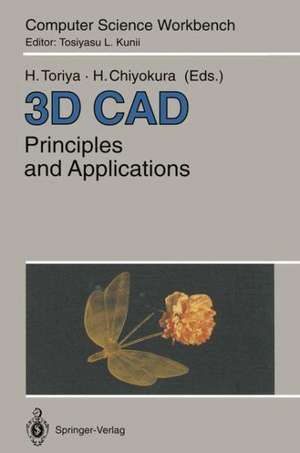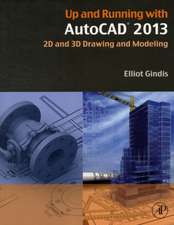3D CAD: Principles and Applications: Computer Science Workbench
Editat de Hiroshi Toriya Traducere de H. Yaguchi Editat de Hiroaki Chiyokuraen Limba Engleză Paperback – 29 feb 2012
Preț: 759.48 lei
Preț vechi: 949.35 lei
-20% Nou
Puncte Express: 1139
Preț estimativ în valută:
145.33€ • 152.43$ • 120.98£
145.33€ • 152.43$ • 120.98£
Carte tipărită la comandă
Livrare economică 01-15 aprilie
Preluare comenzi: 021 569.72.76
Specificații
ISBN-13: 9783642457319
ISBN-10: 3642457312
Pagini: 300
Ilustrații: XIII, 282 p. With 1 Falttafel.
Dimensiuni: 155 x 235 x 16 mm
Greutate: 0.42 kg
Ediția:Softcover reprint of the original 1st ed. 1993
Editura: Springer Berlin, Heidelberg
Colecția Springer
Seria Computer Science Workbench
Locul publicării:Berlin, Heidelberg, Germany
ISBN-10: 3642457312
Pagini: 300
Ilustrații: XIII, 282 p. With 1 Falttafel.
Dimensiuni: 155 x 235 x 16 mm
Greutate: 0.42 kg
Ediția:Softcover reprint of the original 1st ed. 1993
Editura: Springer Berlin, Heidelberg
Colecția Springer
Seria Computer Science Workbench
Locul publicării:Berlin, Heidelberg, Germany
Public țintă
ResearchCuprins
1 Outline of CAD/CAM/CAE.- 1.1 Introduction.- 1.2 CAD System.- 1.3 CAM System.- 1.4 CAE System.- 1.5 3D CAD Systems.- 2 3D CAD Systems and Solid Models.- 2.1 Introduction.- 2.2 How to Represent Solids.- 2.3 Advantages of a Solid Modeler.- 2.4 Representation of Objects in a Solid Modeler.- 2.5 Comparison of CSG and Boundary Representations.- 3 Solid Modeler DESIGNBASE.- 3.1 Introduction.- 3.2 Features of DESIGNBASE.- 3.3 Software Structure of DESIGNBASE.- 3.4 Data Structure of Boundary Representations.- 3.5 Primitive Operations.- 3.6 An Example of Primitive Operations.- 4 Free-Form Curves.- 4.1 Introduction.- 4.2 Parametric Curves.- 4.3 Bézier Curves.- 4.4 Rational Bézier Curves.- 4.5 B-Spline Curves.- 4.6 NURBS.- 4.7 Programs.- 5 Free-Form Surfaces.- 5.1 Introduction.- 5.2 Quadric Surfaces.- 5.3 Parametric Patches.- 5.4 Coons Surfaces.- 5.5 Bézier Surfaces.- 5.6 Rational Bézier Surfaces.- 5.7 NURBS.- 5.8 Gregory Patches.- 5.9 Rational Boundary Gregory Patches.- 5.10 Connection of Patches.- 5.11 Interpolation of Patches.- 5.12 Transformation of Patches.- 5.13 Programs.- 6 Intersection Calculations.- 6.1 Introduction.- 6.2 Intersection Calculations Between Curves.- 6.3 Intersection Calculations Between a Curve and a Surface.- 6.4 Intersection Calculations Between Surfaces.- 6.5 Intersection Calculation in DESIGNBASE.- 7 Local Operations.- 7.1 Introduction.- 7.2 Creation and Modification of Solids with Surfaces.- 7.3 Primitive Solid Generation.- 7.4 Local Modification Operations.- 7.5 Programs of Local Operations.- 8 Boolean Operations.- 8.1 Introduction.- 8.2 Boolean Operations of Solids with Free-Form Surfaces and Their Problems.- 8.3 Boolean Operation Algorithm in DESIGNBASE.- 9 Rounding Operation.- 9.1 Introduction.- 9.2 Problems with the Rounding Operation.- 9.3Rounding Operation in DESIGNBASE.- 9.4 Example of Rounding Operation Execution.- 9.5 Algorithm of Rounding Operation.- 9.6 How to Calculate Trajectories Drawn by Tangent Points.- 10 Functions in Aiding Design.- 10.1 Introduction.- 10.2 Parametric Design.- 10.3 UNDO · REDO Operations.- 10.4 Creation of Similar Shapes.- 11 Rendering.- 11.1 Introduction.- 11.2 Color Components and Shading Model.- 11.3 Z-Buffer Method.- 11.4 Scan Line Method.- 11.5 Ray Tracing Method.- 11.6 Mapping Method.- 12 Mass Properties.- 12.1 Introduction.- 12.2 How to Obtain Surface Area.- 12.3 How to Obtain Volume, Center of Gravity, and Moment of Inertia.- 12.4 Mass Property Calculation in DESIGNBASE.- 13 3-Dimensional Modeling Method.- 13.1 Introduction.- 13.2 Resin Model Creation System.- 13.3 Link with Modeler.- 13.4 DESIGNBASE and Resin Model Creation System.- 14 Solid Models and Structure Analysis.- 14.1 Introduction.- 14.2 History of Finite Element Method.- 14.3 Finite Element Method and Solid Models.- 14.4 3-Dimensional Mesh Generation.- 14.5 KSWAD — Integrated CAE System.- References.



























